Up Next
Rising Talent Bea Scaccia’s Otherworldly Paintings Capture the Harmony—and Tension—Between Beauty and Monstrosity
The artist is preparing a series of fairytale-inspired paintings to debut at Art Brussels in the spring.
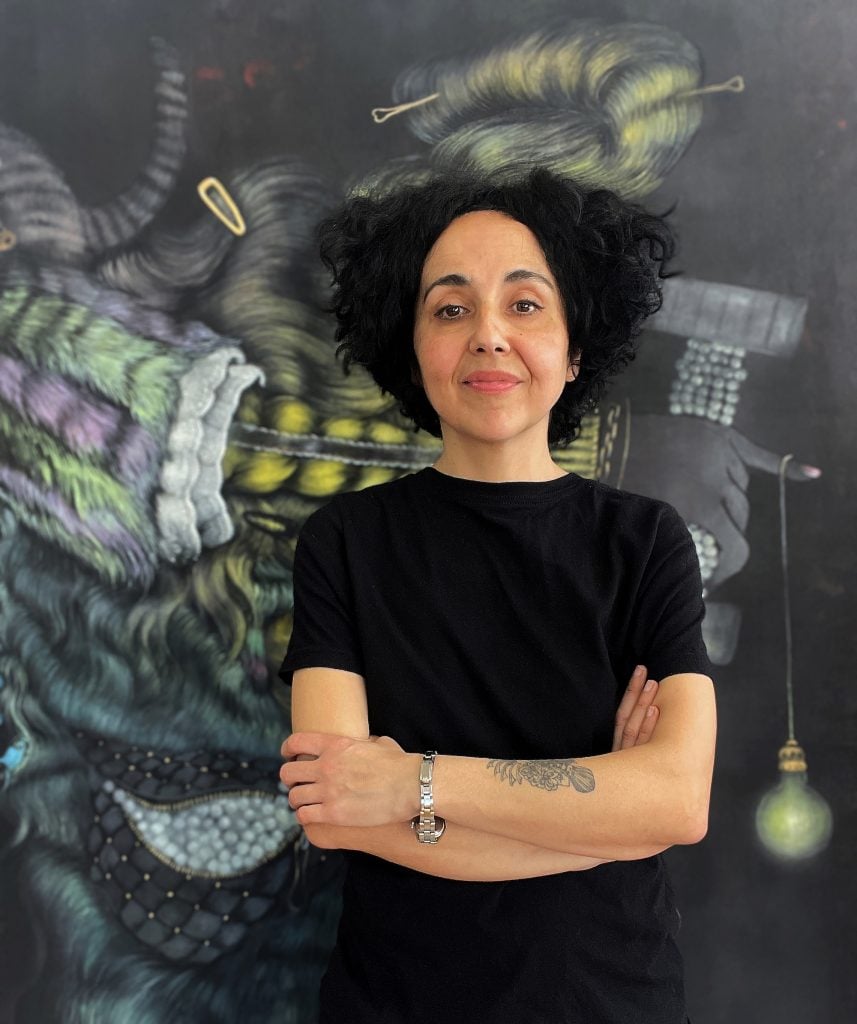
The artist is preparing a series of fairytale-inspired paintings to debut at Art Brussels in the spring.

Katie White

French author Charles Perrault’s 1695 fairytale Donkeyskin is a story of how women must sometimes become monstrous to survive. A beautiful queen’s dying wish is that her husband, the king, remarries a woman as fair and talented as she. The only match for his late wife—the king discerns—is the couple’s own daughter. Under the guidance of her fairy godmother, the horrified princess disguises herself in the hide of a donkey to avoid detection and flees to another kingdom where she finds safety. Taking work on a farm, the princess, still clad in the hide, is so unsightly that the town’s people nickname her Donkeyskin. In the privacy of her lodgings, however, the princess returns to her regal ways, when a handsome prince eventually discovers her.
This disquieting tale is the inspiration behind New York-based, Italian artist Bea Scaccia’s (b. 1978, Frosinone, Italy) new body of work, paintings that explores the tensions and interplays between beauty and monstrosity, gender and identity.
When I visit Scaccia in her Long Island City studio one afternoon, in-progress paintings lined the walls, creating a theatrical tableau. Her nocturnal scenes picture wallpapered rooms and seem to glow uncannily from the inside out. Hair—wigs or fur, one can’t quite discern—acts as the peculiar protagonists for these images, occupying the canvases with their eerie and unnatural hues of acidy yellow, bluish greens, and passages of purple. Hands and arms, extended in long gestures, cross through the hair and fur and offer our only hints of human presence.
“The fairytale is very beautiful. I think of this tension between the very ugly animal skin and the description of the princess’s beautiful white hands,” explained Scaccia of her paintings. “Beauty exists underneath and the disguise itself is what helps her to find her identity. Women always try to escape back to the animal form in mythology as a kind of protection”
This newest series is being prepared for a debut next spring at Art Brussels with Maruani Mercier Gallery. Scaccia’s evocative paintings, which dance between the grotesque and the glamorous, the representational and the surreal, have been drawing attention from gallerists and collectors alike over the past few years. Earlier this spring, she presented new works at NADA with New York’s JDJ Gallery, in a follow-up to her debut solo show with the gallery, “With Their Striking Features,” in 2022. She was also included in “Death Of Beauty,” a group show at Sargent’s Daughters’s Los Angeles location earlier this year.
The paintings occupy a unique space—ornamented, feminine, and decidedly dark.
“I am so personally fascinated by her line of gender inquiry within her work, and how her compositions dance precariously on the delicate line between femininity and monstrosity,” Jayne Drost of JDJ explained to me. “I believe that Bea is creating worlds within her paintings, and while these worlds feel unique, they are rooted within myths, stories, stereotypes, and cultural traditions that are centuries old, yet feel evergreen.”
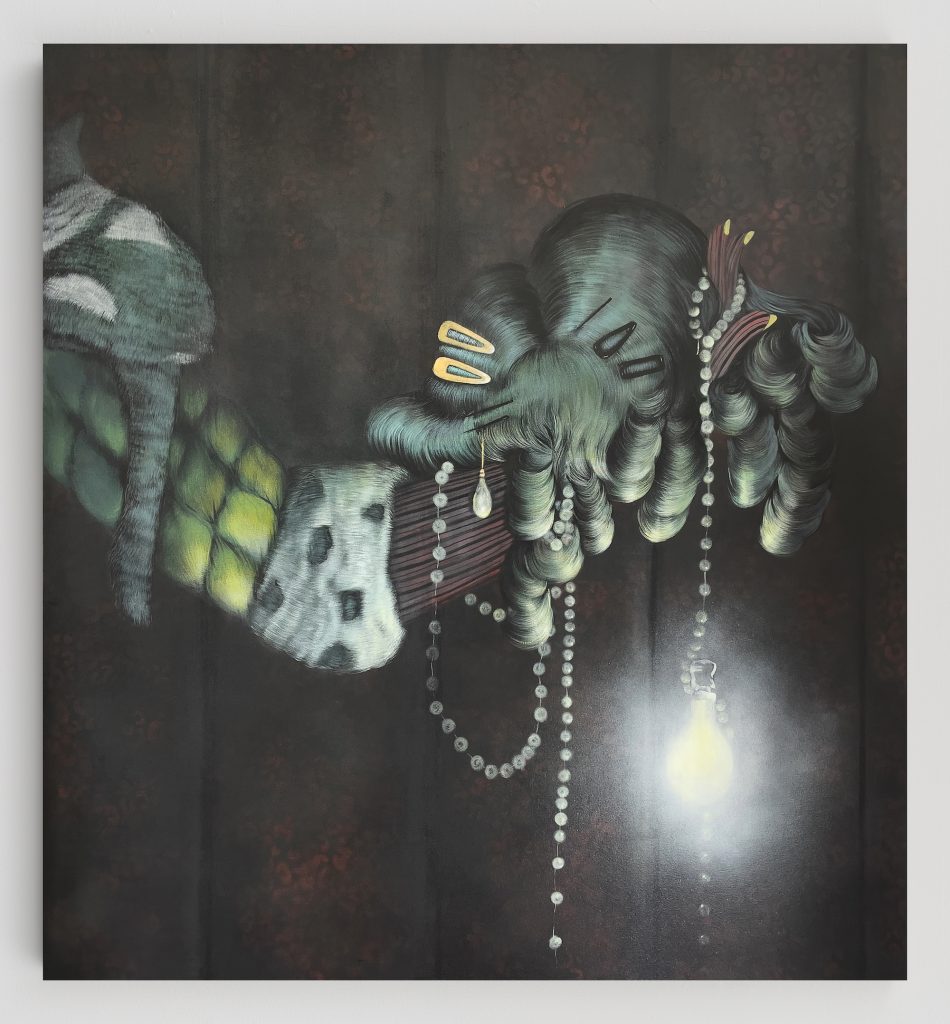
Bea Scaccia, Yellow Vermeer (2023). Courtesy of the artist.
Others have agreed. This winter, Scaccia will be in residency with the Marea Art Project in Praiano along Italy’s Amalfi Coast. She was personally invited by Carol LeWitt, collector and wife of late artist Sol LeWitt, whose ancestral home Casa L’Orto houses the residency, after LeWitt saw her work in a social media post shared by the Katonah Museum of Art. There, Scaccia plans to develop new works that center on local Italian myths and storytelling. In the lead-up, the artist has been gladly spending long days in the studio, often arriving at dawn and working for stretches of 10, even 12 hours at a time. She feels there is no time to be wasted.
Scaccia grew up in the small town of Veroli and then studied and taught at Rome’s Academy of Arts for much of her adult life. She came to New York for a residency about a decade ago and decided she needed to make her career here. “Even though I’m Italian, I felt more welcome here,” she said. “Rome can be very closed, especially to women.”
Taking jobs from gig work to babysitting in New York, Scaccia ultimately found employment in the studio of Jeff Koons and subsequently, Marilyn Minter. In these roles, she was coveted for both her hyperrealist ability and speed. At the same time, she felt was floundering in her own creative development.
“I spent years copying other artists and I couldn’t figure out how to paint for myself. I was playing with Photoshop and building references, but I always was disappointed. I even went to therapy once—only one session because it was too expensive—to figure out why I couldn’t paint. That was maybe 2018,” she explained. “One day, I decided maybe I didn’t need the reference imagery anymore. That was what was keeping me stuck. I didn’t want to be realistic: reality was not fulfilling to me.”
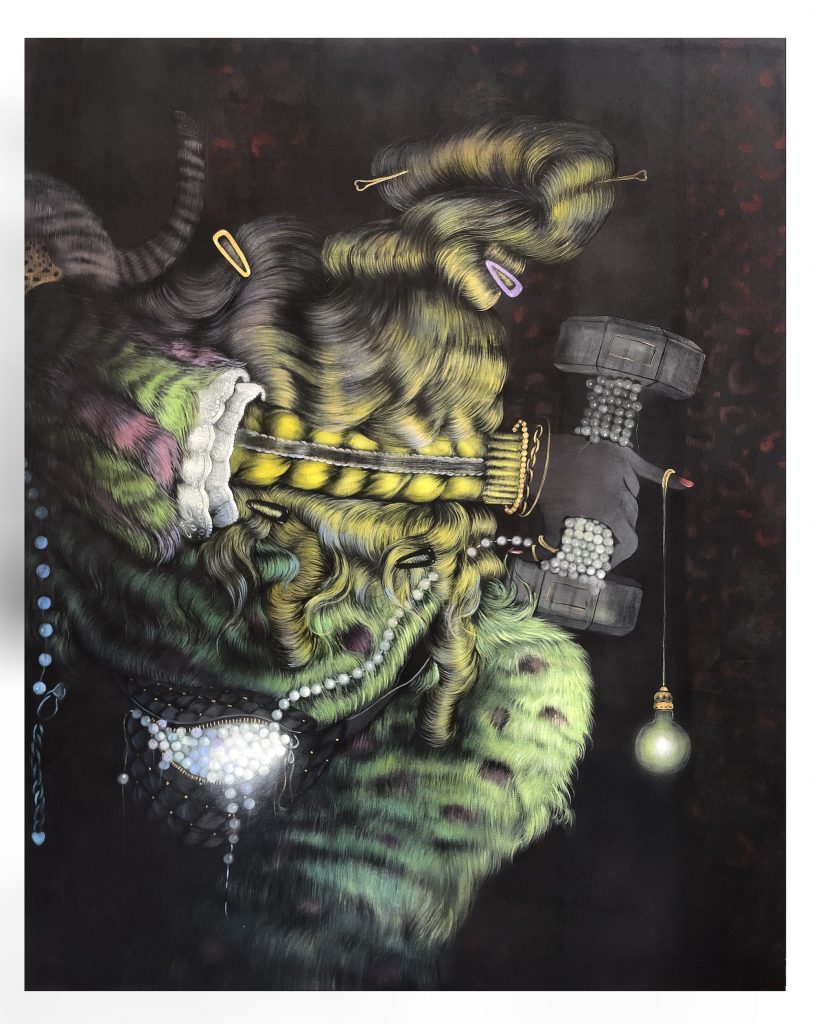
Bea Scaccia, Weighing Up Her Options (2023). Courtesy of the artist.
Now, her process is far more intuitive. Sometimes Scaccia sketches at home in bed, configuring elements in ways she finds intriguing. Sometimes she starts with no sketch at all. She starts her canvases typically airbrushing some elements and patterns into her backgrounds, and then paints in acrylic, adding and subtracting elements and shifting tones. She works on several canvases at a time, moving to the next work when the process begins to feel forced. “I find solutions when I move on,” she explained.
While her paintings are not realistic, they are richly referential. Her studio is a treasure trove of books on art history, fairytales, and myths. Clips of colorful wigs and feathers are pinned here and there to the studio walls.
“Come look at this,” she said to me, opening a plastic bag. The bag was filled with tangles and tangles of costume jewelry. “I was looking online for really excessive, disturbing-looking jewelry and this came up. You can basically buy people’s drawers of junk jewelry,” Scaccia said, holding up the mass of cheap jewels like an amulet. “This was only $10.”
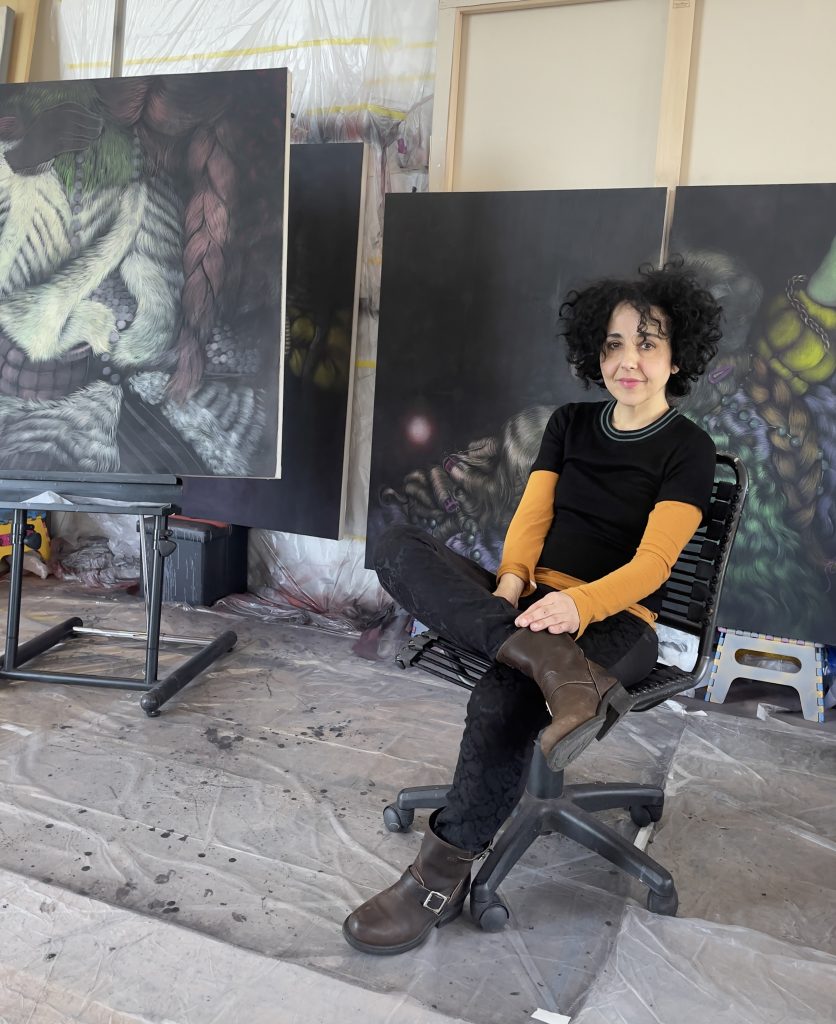
Bea Scaccia in the studio, 2023.
The jewelry will be put to good use. Adornments abound in her canvases. Pearls are a recurring motif, appearing in clusters so opulent as to become distressing.
“Pearls bring to mind the Renaissance, of course,” Scaccia said. “A symbol of beauty in a classical composition becomes almost an infestation, something you cannot get rid of. I operate in an excess of everything. I’ll add too many pearls, too many purses, too many clips.”
Hair, similarly, becomes over-the-top, a performance of identity, a warning. “I have doubts every day that we ever know who we are,” Scaccia mused. “But the surface is actually our deepest depth. The way we present ourselves gives us a sense of stability; performance gives us our idea of continuity. If you think about Renaissance hairdos—they were perfection—and these hairdos seemed like they could stay like that forever. But with this sense of beauty, you also realize how dirty it must have been too.”
Theater is never far from hand. In these most recent works, lone light bulbs hang overhead, an element that brings to mind the work of Francis Bacon and Philip Guston, but also a stage set. We can imagine actors backstage in a dressing room pulling on and off garments in these paintings. One vestige of clothing I recognize in her paintings—a lemony yellow morning coat with an ermine fur trim—is a reimagining of a coat Vermeer costumed many of his models in.
“Even though I’m Italian and the Renaissance is everywhere, I’ve always loved the Northern painters, especially Vermeer,” Scaccia remarked, “It’s the attention to detail and the artifice that I love [about] Flemish artists.”
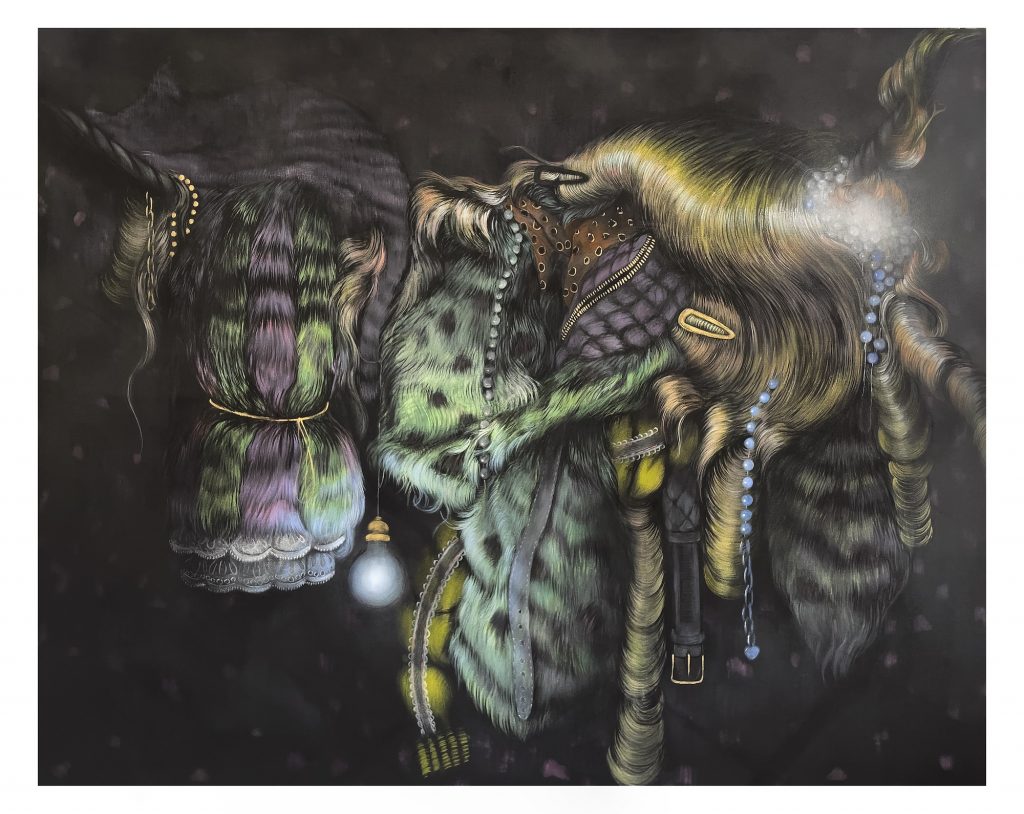
Bea Scaccia, Shall We Hang Out (2023). Courtesy of the artist
For Scaccia, these elements of staging and costuming serve a transformative function. She noted the work of Domenico Gnogli and artist and writer Alberto Savinio as influences in her understanding of metamorphosis. “Right now, we’re living in a Baroque period full of turmoil and scientific discovery,” she said. “We’ve lost everything that was the animal part of us and so we wear it as the protection that we need.”
When I ask where her interests will take her next, Scaccia told me she’s scaling up. “I think these paintings can get bigger,” she said. She’s also turning her eye to cats and proverbial cat ladies, in the grand tradition of her compatriot Leonor Fini. I begin to notice a cat tail here or there in her paintings.
“While reading all these fairytales, I realized cats are feminine. And they’re feminine in a certain kind of way, belonging to the witchy cat ladies who are always alone in the stories we hear. But women get the cats to feel safer,” she said, looking around the studio. “They’re not the scary ones. We never really think about that.”